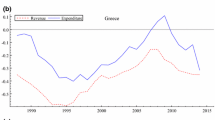Abstract
We propose a Markov switching cointegration approach to assess long run fiscal sustainability. This method allows us to simultaneously: (1) test for cointegration in the presence of significant fiscal policy changes; (2) assess the type of fiscal regime that a country experienced at a given period and (3) analyse the timing of the transition between the estimated regime types. Given its flexibility, our approach enable us to uncover a richer and more complex dynamics in the analysis of fiscal sustainability, which standard linear cointegration methods fail to capture.
Similar content being viewed by others
References
Ahmed S, Rogers JH (1995) Government budget deficits and trade deficits: are present value constraints satisfied in long-term data? J Monet Econ 36: 351–374
Alexandre F, Bacao P, Gabriel VJ (2007) Volatility in asset prices and long-run wealth effect estimates. Econ Model 24: 1048–1064
Andrews DWK, Monahan JC (1992) An improved heteroskedasticity and autocorrelation consistent covariance matrix estimator. Econometrica 60: 953–966
Baharumshah AZ, Lau E (2007) Regime changes and the sustainability of fiscal imbalance in East Asian countries. Econ Model 24: 878–894
Bohn H (2007) Are stationarity and cointegration restrictions really necessary for the intertemporal budget constraint? J Monet Econ 54: 1837–1847
Choi I, Saikkonen P (2009) Testing for nonlinear cointegration. Econ Theory (forthcoming)
Corradi V, Swanson NR, White H (2000) Testing for stationarity-ergodicity and for comovements between nonlinear discrete time Markov processes. J Econ 96: 39–73
Davies A (2006) Testing for international equity market integration using regime switching cointegration techniques. Rev Financ Econ 15: 305–321
Gabriel VJ, Psaradakis Z, Sola M (2002) A simple method of testing for cointegration subject to multiple regime change. Econ Lett 76: 213–221
Gregory AW, Hansen BE (1996a) Residual-based tests for cointegration in models with regime shifts. J Econ 70: 99–126
Gregory AW, Hansen BE (1996b) Tests for cointegration in models with regime and trend shifts. Oxford Bull Econ Stat 58: 555–560
Hakkio CS, Rush M (1991) Cointegration and government borrowing constraints: evidence for the United States. J Bus Econ Stat 9: 429–445
Hall SG, Psaradakis Z, Sola M (1997) Cointegration and changes in regime: the Japanese consumption function. J Appl Econ 12: 151–168
Hamilton JD, Flavin MA (1986) On the limitations of government borrowing. A framework for testing. Am Econ Rev 76: 808–819
Hansen BE (1992) Tests for parameter instability in regressions with I(1) processes. J Bus Econ Stat 10: 321–335
Hansen PR (2003) Structural breaks in the cointegrated vector autoregressive model. J Econ 114: 261–295
Haug AA (1991) Cointegration and government borrowing constraints: evidence for the United States. J Bus Econ Stat 9: 97–101
Haug AA (1995) Has federal budget deficit policy changed in recent year? Econ Inq 33: 104–118
Johansen S (1988) Statistical analysis of cointegration vectors. J Econ Dyn Control 12: 231–254
Kalyoncu H (2005) Fiscal policy sustainability: test of intertemporal borrowing constraints. Appl Econ Lett 12: 957–962
Kim CJ, Nelson CR (1999) State-space models with regime switching. MIT Press, Cambridge
Krolzig HM (1999) Statistical analysis of cointegrated VAR processes with Markovian shifts. Humboldt University Working Paper 373
MacKinnon JG (1991) Critical values for cointegration tests. In: Engle RF, Granger CWJ (eds) Long-run economic relationships. Oxford University Press, Oxford, pp 267–276
Martin GM (2000) US deficit sustainability: a new approach based on multiple endogenous breaks. J Appl Econ 15: 83–105
Payne JE (1997) International evidence on the sustainability of budget deficits. Appl Econ Lett 4: 775–779
Payne JE, Mohammadi H, Cak M (2008) Turkish budget deficit sustainability and the revenue-expenditure nexus. Appl Econ 40: 823–830
Psaradakis Z, Sola M, Spagnolo F (2004) On Markov error-correction models, with and application to stock prices and dividends. J Appl Econ 19: 69–88
Quintos CE (1995) Sustainability of the deficit process with structural shifts. J Bus Econ Stat 13: 409–417
Stock JH, Watson MW (1993) A simple estimator of cointegrating vectors in higher order integrated systems. Econometrica 61: 783–820
Wilcox D (1989) The sustainability of government deficit: implications of the present-value borrowing constraint. J Money Credit Banking 21: 291–306
Author information
Authors and Affiliations
Corresponding author
Rights and permissions
About this article
Cite this article
Gabriel, V.J., Sangduan, P. Assessing fiscal sustainability subject to policy changes: a Markov switching cointegration approach. Empir Econ 41, 371–385 (2011). https://doi.org/10.1007/s00181-010-0369-4
Received:
Accepted:
Published:
Issue Date:
DOI: https://doi.org/10.1007/s00181-010-0369-4



